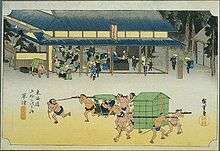Kusatsu-juku



Kusatsu-juku (草津宿 Kusatsu-juku) was the fifty-second of the fifty-three stations of the Tōkaidō as well as the sixty-eighth of the sixty-nine stations of the Nakasendō. It is located in the downtown area of the present-day city of Kusatsu, Shiga Prefecture, Japan.
History
Coming from Moriyama-juku, the borders of Kusatsu-juku started at the banks of the Kusatsu River to the present-day Miya-chō in Kusatsu. The famed ukiyo-e artist Hiroshige traveled through the post station using both the Tōkaidō and the Nakasendō in order to create woodblock prints.
In 1843, the post station had 2,351 residents and 586 buildings. Among the buildings, there were two honjin, two sub-honjin, and 72 hatago. Of the two honjin, one was constructed in 1635 and stood until 1870.[1] That honjin was later repaired and opened as a museum in 1996.[1]
Neighboring post towns
- Nakasendō
- Moriyama-juku - Kusatsu-juku - Ōtsu-juku
- Tōkaidō
- Ishibe-juku - Kusatsu-juku - Ōtsu-juku
References
![]() Media related to Kusatsu-juku at Wikimedia Commons
Media related to Kusatsu-juku at Wikimedia Commons
- 1 2 Kusatsu-shi, Kusatsu-juku. City of Kusatsu. Accessed July 17, 2007.
Coordinates: 35°01′03.6″N 135°57′37.7″E / 35.017667°N 135.960472°E